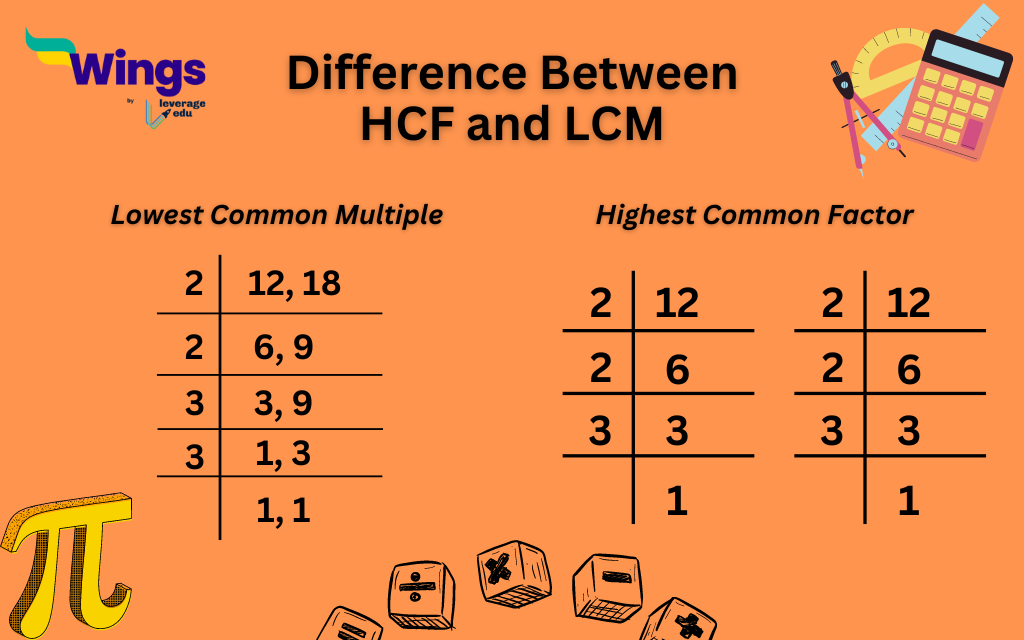HCF and LCM are two mathematical ways to tackle Real numbers. The Full Form of HCF is the Highest Common Factor and is also known as the Greatest Common Divisor. Moreover, the Full Form of LCM is the Least Common Multiple. Furthermore, there are two methodologies that are undertaken to solve HCF and LCM of numbers, which are the Division Method and the Prime Factorisation Method, which we shall explore right here in this blog along with the Examples.
Kindly note: The word ‘Factor’ is interchangeable with ‘Divisior.’
HCF (Highest Common Factor)
People use the Highest Common Factor to find the Greatest common divisor between two or more numbers, which helps simplify fractions, solve equations, and understand the fundamental relationship between numbers.
What is the Formula of HCF by the Division Method?
There is no specific formula for calculating the HCF by the Division Method. However, there are Steps to calculate the HCF by the Division Method.
- You need to divide the larger number by the smaller one.
- Then divide the divisor by the remainder.
- Continue dividing the last divisor by the last remainder until the remainder is zero.
- The last divisor is the HCF.
Example of HCF by the Division Method
For example, when finding the HCF of 24 and 36, you would divide 36 by 24, then 24 by the remainder until the remainder is zero, resulting in the HCF of 12.
36 ÷ 24 = 1 (remainder 12)
24 ÷ 12 = 2 (remainder 0)
So, the HCF of 24 and 36 is 12.
What is the Formula of HCF by the Prime Factorisation Method
To find the HCF of two numbers using Prime factorisation, express each number as a product of prime factors. Then, take the product of the common prime factors with the lowest powers.
Example of HCF by the Prime Factorisation Method
In the prime factorisation method, if we take the numbers 24 and 36, their common prime factors are 2 and 3. So, the HCF is the product of these common prime factors, which is 6.
- Prime factors of 24: 2 ✕ 2 ✕ 2 ✕ 3 = 2^3 ✕ 3
- Prime factors of 36: 2 ✕ 2 ✕ 3 ✕ 3 = 2^2 ✕ 3^2
- Common prime factors: 2 ✕ 3 = 6
- So, the HCF of 24 and 36 is 6.
Also Read: 50 + Problems on H.C.F and L.C.M Questions and Answers | Quantitative Aptitude📖
LCM (Least Common Multiple)
People use the Least Common Multiple to find the least common multiple of two or more numbers. This is important for different real-life scenarios such as scheduling events, calculating time intervals, or solving problems in algebra and geometry.
What is the Formula of LCM by the Division Method?
To find the LCM of two numbers using the Division method, you need to multiply the two numbers and divide by their HCF.
Example of LCM by the Division Method
To find the LCM of 24 and 36 using the Division method, we first need to find their HCF, which we previously calculated to be 12.
Now, using the formula LCM = (24 ✕ 36) ÷ HCF(24, 36), we substitute the values:
LCM = (24 ✕ 36) ÷ 12
= (864) ÷ 12
= 72
Thus, the LCM of 24 and 36 using the Division method is 72.
What is the Formula of LCM by the Prime Factorisation Method?
To find the LCM of two numbers using prime factorisation, express each number as a product of prime factors. Then, take the product of all the prime factors, including the common factors, with the highest powers.
What is an Example of LCM by the Prime Factorisation Method?
For example, the LCM of 4 and 6:
- Prime factors of 4: 2 ✕ 2 = 2^2
- Prime factors of 6: 2 ✕ 3 = 2 ✕ 3
- LCM: 2^2 ✕ 3 = 12
Find the HCF and LCM of 6, 72 and 120
- Prime factors of 6: 2 ✕ 3
- Prime factors of 72: 2 ✕ 2 ✕ 2 ✕ 3 ✕ 3
- Prime factors of 120: 2 ✕ 2 ✕ 2 ✕ 3 ✕ 5
HCF: Common prime factors with the lowest powers: 2 ✕ 3 = 6
LCM: Product of all prime factors with the highest powers: 2^3 ✕ 3^2 ✕ 5 = 360
Thus, the HCF of 6, 72, and 120 is 6, and the LCM is 360.

Did you like learning about the HCF and LCM? Keep on reading our blogs to learn more about the basic concepts of Maths!
 One app for all your study abroad needs
One app for all your study abroad needs














